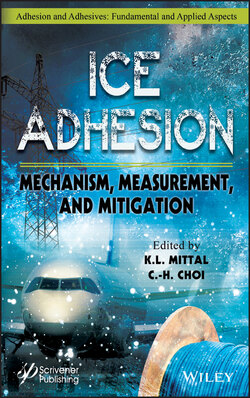Читать книгу Ice Adhesion - Группа авторов - Страница 32
2.1 Introduction
ОглавлениеPhase transitions of water play a prominent role in many natural processes like fog and cloud formation, precipitation as rain, snow or hail. In technical applications such as heat exchangers, fog harvesting or water desalination, high nucleation and condensation rates are favored; while in the case of anti-icing coatings, one targets for suppression of nucleation. These phase transitions occur when the original phase is supersaturated with respect to a more stable one. The formation of a new phase within a metastable original phase (i.e., mother phase), however, does not begin in a continuous manner. It rather arises spontaneously as a result of fluctuations of temperature and density in the original phase when a critical supersaturation of vapor or a critical supercooling of liquid water is exceeded. This spontaneous process is called nucleation.
As an established research area, the development of nucleation theory has been a long, gradual process, taking almost 100 years. Based on Gibbs’ thermodynamic works from the end of 19th century, Volmer and Weber formulated the first kinetic model of nucleation for the vapor-to-liquid phase transition in 1926 [1, 2], which was further developed by Farkas [3], Becker [4], and Zeldovich [5]. Later, Turnbull and Fisher extended this theory to the crystal nucleation from liquid by redefining the kinetic model in the liquid phase [6]. These works constitute the “classical nucleation theory”, which provides a ready explanation for various nucleation processes [7-12]. It was originally developed for the ideal case of homogeneous nucleation, which involves the two phases of one material only. In practical situations, however, one has typically to deal with heterogeneous nucleation, where the presence of a third phase of another material (e.g., aerosol particles and solid surfaces) acts as nucleation site. This opens the way to control the nucleation in phase transitions by designing corresponding surfaces of the third phase. Recently, water condensation [13-24] and icing [25-32] involving heterogeneous nucleation on functional surfaces, has attracted much attention due to its significance in energy and environmental applications. To improve the condensation and anti-icing performance, durable super-hydrophobic [33-45] and super-icephobic surfaces [46-56] are urgently required in multiple industries, such as power generation, water harvesting, aviation, etc. Guided by the classical nucleation theory, considerable progress has been achieved in manipulating heterogeneous nucleation via surface topography [57-61] and chemistries [62-71]. Studies of interfacial effects on water molecules, e.g., surface charge [72-77] and recrystallization inhibitors [78-81], also enrich the understanding of water properties and nucleus formation at interfaces. To date experimental exploration of nucleation embryos remains inadequate, although considerable research effort using numerical investigations has been made [82-87].
In this chapter, classical nucleation theory is introduced and applied to derive nucleation rates for the two cases of homogeneous and heterogeneous nucleations. The results are used for analyzing the initial steps of both water condensation and ice crystallization. On that basis, we subsequently discuss the recent progress in the field of controlling heterogeneous nucleation on solid surfaces for achieving enhanced condensation or ice inhibition.
